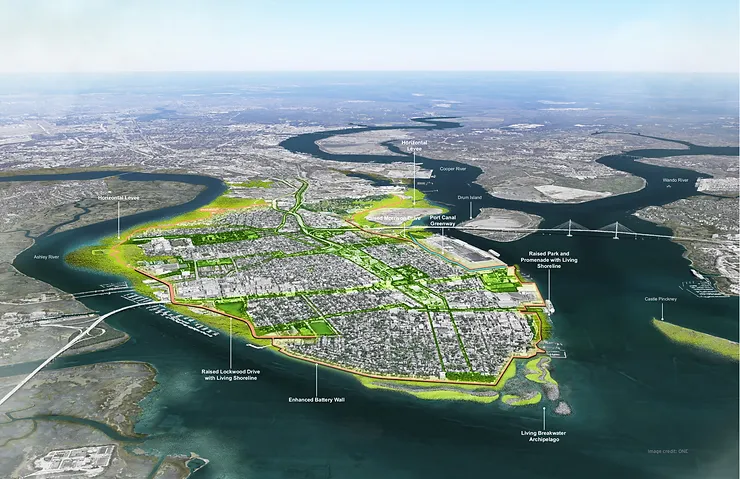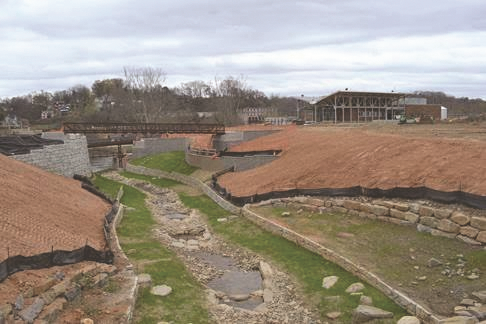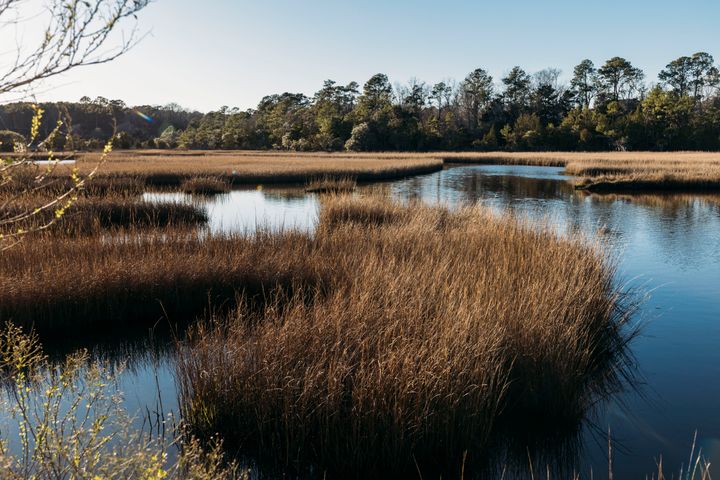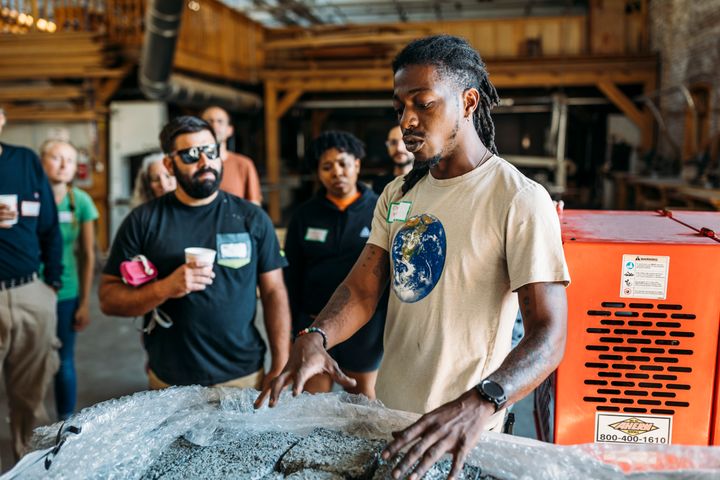Imagine the Wall: Charleston 2030 Project

CHARLESTON 2030 PROJECT
Highlighting aspirational, ecofuturist visions for the Lowcountry
by Belvin Olasov
The climate crisis will inevitably thrust us into a different world – the question is how much of that world we’ll get to choose. For Charleston, it’s hard to find that question in a sharper form than the Charleston Sea Wall, a plan by the US Army Corps of Engineers for a concrete wall and series of gates and pumps to protect the Peninsula from hurricane surge waves. For the past few years, the City has been mulling over the Army Corps’ proposal, weighing its potential protective benefits against the price tag and concern over losing Charleston’s connection to the water to ugly, blocky barriers.
An alternative vision was put together by a team working with environmental engineer Keith Bowers, founder of ecological restoration and regenerative design company Biohabitats, in the spring of 2020: Imagine the Wall. The project, a counterproposal of sorts to the Army Corps’, presents a version of the Sea Wall that uses nature-based solutions, allows for adaptation over time, and is grounded in an appreciation for community and place.
Bowers was inspired to jump into the fray when he saw the Army Corps’ initial proposal for a sea wall and found it to be an overly simplistic solution, divorced from environmental and cultural context. He recognized the ways in which the Army Corps were restricted and thought his firm’s experience with nature-based infrastructure could be a useful complement.
“I think what people don't realize or just don't know about is when the Corps studies something like this, they have very narrow guidelines and policies that they have to follow,” Bowers said. “Personally, I think a lot of the Corps folks would love to deviate out of that and take into consideration all these other aspects, but because of how legislation is worded, they're not allowed to.”
The initial seawall proposal came out in early 2020 – the COVID-19 pandemic shutdown had just come in full force, and work had slowed down for Biohabitats, as well as a number of partner firms like Design Works. A casual conversation with Scott Parker of Design Works led to inspiration.
“I said, you know, if you have some idle people sitting around and we have some idle time… why don't we put out a counterproposal to what the corps is doing? Just to spark people's imaginations.”
They formed an ad-hoc team of themselves, local coastal engineering firm ATM, and One Architecture, a Dutch firm that made a name for themselves with their coastal protection project for lower Manhattan. One Architecture’s experience designing an urban sea wall (of which there are few) that isn’t monofunctional infrastructure (of which there are even fewer) had taught them how important adaptability, multiple co-benefits, and connection to place and community were to these projects. Creating solutions that were iterative and adaptable was seen as crucial.
“One of the things that is really a challenge for Army Corps projects, once you start to think about climate in general, is that what you designed for now, and what you may have budgeted for now, will need to be adapted at some later stage. Because the climate crisis will not stop.” said Matthjis Bouw, founder of One Architecture. “There’s already so much carbon in the air that we’re stuck with this for the next century or more.”
As they were consciously avoiding the monolithic, one-size-fits-all approach, the team put together custom-tailored approaches for various sea level rise hotspots around the Peninsula. They centered the principles of the Dutch Dialogues – working with water, not against it, and centering natural, liveable solutions – and environmental justice. And they gave themselves permission to be creative, proposing big ideas that drew on their shared experience of what works in the field.
“It is a real struggle to get this type of coastal protective system built in an integrated way. They're sort of a new type of infrastructure – cities and their agencies are not ready for it, and they don't have practices in place,” Bouw said. “So having that vision and committing to a vision at a very high level is really important, because it spurs everyone to, every day, try their best to come as close to the vision as possible.”
Port Canal

The Army Corps proposal prescribed a series of gates and pumps, but Imagine the Wall’s alternative vision would integrate water management into public amenity, using planted terraces as a wall and a canal with floodable marsh to retain stormwater and alleviate flooding. They saw the East Bay St. location as a potential public good and valuable pedestrian connection to the Ravenel Bridge.
“Some people might think of that area, because it's right next to the Railyard, that there's not an opportunity for making space better,” said Mathew Staudt, studio director at One Architecture. “But in fact, when we started looking at it in more detail, there's some really wonderful oak trees that people really find important there. We just really saw an opportunity to do more of a kind of urban throughway there that could make the experience actually much better.”
Morrison Drive and Brittlebank Park Horizontal Levee

Making Brittlebank Park into a horizontal levee, inspired by Biohabitats’ proof of concept work in San Francisco Bay, would mean implementing a gradual incline, so when sea level rise starts to kill off the marsh at its edge, the marsh can migrate up and landward. The slope would terminate at an elevated Lockwood Drive – not only would this protect a vital transportation link to the Medical District, but the raised street itself would serve as a perimeter storm surge barrier. Bowers sees a modular approach as key to the idea’s feasibility.
“You can scale that over time,” Bowers said. “You might not need that 12 feet now, you might be able to get away with six feet now. And maybe in 10 years you've got to increase it as storm surges begin to happen more, and sea level rise happens, and you can build on it.”
Living Breakwater Archipelago

The Peninsula was first known to early English settlers as Oyster Point, and Imagine the Wall looks to return to those roots with living breakwater, a multifaceted, nature-based approach to reducing wave energy. These structures, mixing the organic and the engineered, would provide shelter for fish, crabs, marsh birds and shorebirds, as well as maintaining oyster reefs. The Living Breakwater Archipelago would also serve as a venue for public enjoyment of birding, nature education, and kayaking, and retain views that more traditional breakwater systems would block.
“The City is already just really tied to the water. Many cities over time have created some distance from the waterfront, and we’re only now in the last few decades rediscovering what it means to be along the waterfront in the city. And there's something about Charleston where that was never lost,” said Mathew Staudt.
The Future of Sea Level Rise in Charleston
The Imagine the Wall project came out of a lot of expertise and vision, but in a short window. Mattjis said that given more time and community input, there would be more focus on equity in the proposal. “You don’t want Charleston to become a sort of tale of two cities,” he said.
The Army Corps Sea Wall proposal has come under fire for stopping short of Rosemont and Bridgeview Terrace, neighborhoods with lower-income, Black residents. Locals are concerned that by stopping the wall just before them, they’d take the storm surge that bypassed the rest of the Peninsula. Bowers sees this as systemic racism being built directly into the infrastructure process.
“The proposal the Corps has, the wall actually stops prior to protecting these communities. Their reason being that a cost-benefit analysis doesn't pan out. Mainly looking at real estate and saying, if the real estate value is low and this wall is going to cost a certain amount of money, then the cost-benefit doesn't pan out. And by law, they have to reach a certain cost-benefit ratio,” Bowers said. “You could argue that that goes all the way back to redlining and systemic racism. And the reason those property values are low is because of some of those policies that were put in place back in the 40s and 50s and 60s or maybe even longer than that, right? And still to this day, when you look at a project like this, and those property values are lower, that type of systemic racism is still continuing. It's still being perpetuated, I should say.”
The cost of the Army Corps Sea Wall – $384.5 million for the City out of $1.1 billion total, at last count – has been a consistent driver of opposition. Bowers sees the targeted, iterative approach of Imagine the Wall as an affordable way for Charleston to adapt to sea level rise – the projects can start small and be developed five, 10, 20 years down the road as conditions change. He can imagine funding coming from the Corps for the core structural components, transportation funds for the roadway projects, federal and state resiliency funds, commercial private enterprise integration – the list goes on.
Rising to the challenge of the climate crisis and preparing for our future isn’t just a matter of going with old, technocratic solutions, the Imagine the Wall team agreed – it will take a more modern approach.
“The risk is that, because of our radically changing ecology, we will get much bigger division in our society. Ecofascism, ecoapartheid -- those are words other people use. The social impacts of these changes in our earth system are just going to be significant,” Bouw said. “So when I hear the word ecofuturism, I think, well, we all need to work really, really hard to make sure that we have a future that is as good as we can make it for everyone. And that will include rebalancing our urban and our natural systems – taking, when we think about physical systems, social systems into account.”
Imagine the Wall posits a Charleston where we don’t have to choose between safety and livability, aesthetic and function, or effectiveness and environmentalism – by building our way towards a green city that embraces its watery sentence, we can take control over our climate future by accepting it.


